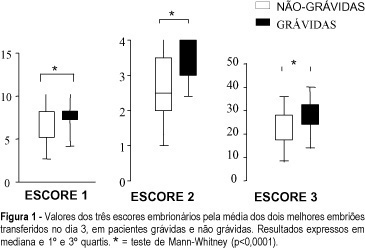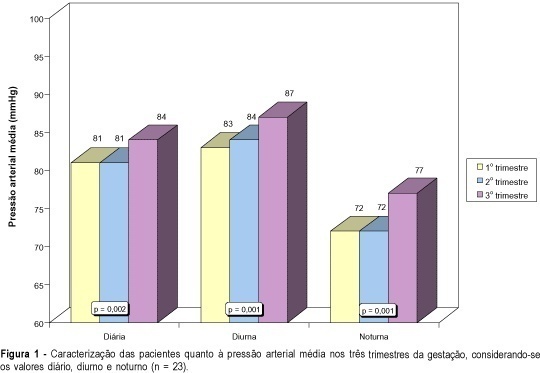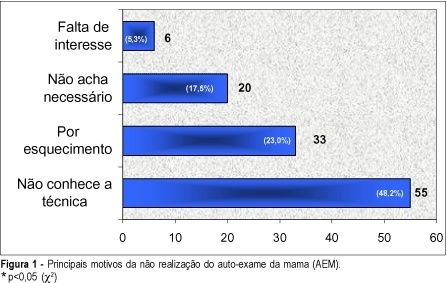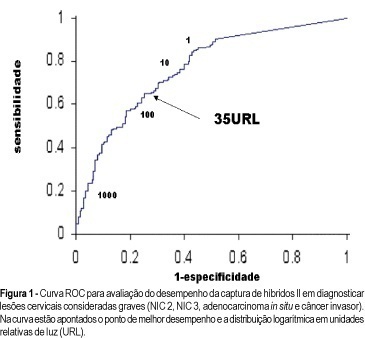Summary
Revista Brasileira de Ginecologia e Obstetrícia. 2003;25(3):177-183
DOI 10.1590/S0100-72032003000300006
PURPOSE: to evaluate three embryo scoring systems specific for 3-day embryos and to correlate them with positive in vitro fertilization outcome. METHOD: retrospective study of the In Vitro Fertilization Program of the University Hospital, Faculty of Medicine of Ribeirão Preto, University of São Paulo. A total of 137 patients submitted to the transfer of 439 embryos were evaluated. The main outcomes measured were pregnancy and implantation rates. RESULTS: a significant difference in the three scoring systems was observed between pregnant (n=53) and non-pregnant (n=84) patients (p<0.0001). In the first embryo scoring system, in which cell number alone was used, higher pregnancy (70%) and implantation rates (42%) were observed when embryos with a mean blastomere number higher than 8 were transferred. Scoring system 2, based on a total four-point score (cleavage stage, blastomere number, fragmentation and symmetry), showed increased pregnancy (52.8%) and implantation rates (31%) for scores above 2. Scoring system 3, based on cell number and morphological criteria, also showed higher pregnancy and implantation rates with increasing average scores of the transferred embryos. CONCLUSION: the three scoring systems assessed in 3-day embryos were positively correlated with pregnancy and implantation rates.

Summary
Revista Brasileira de Ginecologia e Obstetrícia. 2003;25(3):169-176
DOI 10.1590/S0100-72032003000300005
PURPOSE: to compare intra- and postoperative results of vaginal hysterectomy with those of abdominal hysterectomy in women without genital prolapse or adnexal pathology. METHODS: a randomized, open clinical trial was conducted, involving 35 patients without genital prolapse scheduled for total hysterectomy due to benign disease, at IMIP, Recife, Brazil. These patients were randomly assigned to vaginal hysterectomy (19 patients) or abdominal hysterectomy (16 patients). Main outcome measures included estimated blood loss, rate of blood transfusion, duration of surgery, postoperative pain (intensity and analgesic requirement), time in hospital, postoperative complications, recovery time and patient satisfaction. Statistical analysis was performed using chi2, exact Fisher and Mann-Whitney tests at a 5% level of significance. RESULTS: estimated blood losses were significantly lower in vaginal hysterectomy (median of 520 mL) than in abdominal hysterectomy (median 902 mL). There was no blood transfusion among patients of the vaginal hysterectomy group, in contrast to 19% of the abdominal hysterectomy group. Duration of surgery was similar (median of 120 min in both groups). Postoperative pain, as measured by visual analog scale and analgesic requirement, was lower for vaginal hysterectomy than for abdominal hysterectomy. There was no statistically significant difference regarding frequency of postoperative complications. There was one case of infection in each group and one case of thrombosis in the vaginal hysterectomy group. Postoperative hospital stay was shorter in the vaginal group. Recovery time was significantly shorter in the vaginal group (median of 35 days) versus the abdominal group (median 40 days). Overall patient satisfaction with the operation was similar in the two groups. CONCLUSIONS: patients without genital prolapse submitted to vaginal hysterectomy for treatment of benign diseases had some advantages in relation to those submitted to abdominal hysterectomy: lower intraoperative blood loss, lower postoperative pain and faster recovery time. Vaginal hysterectomy may replace abdominal hysterectomy in most patients who require hysterectomy.
Summary
Revista Brasileira de Ginecologia e Obstetrícia. 2003;25(3):163-167
DOI 10.1590/S0100-72032003000300004
PURPOSE: to show longitudinally the profiles and parameters of pressure rhythm and heart rate in normotensive pregnant women during the three trimesters of pregnancy. PATIENTS AND METHODS: the longitudinal and random study involved 23 normotensive pregnant women, mean age 23.3 ± 3.9 years, recruited from the prenatal clinics of the "Maternidade-Escola Hilda Brandão - Santa Casa de Belo Horizonte/MG". Ambulatory blood pressure monitoring was done every three months (up to 14 weeks, between 18 and 28 weeks and between 32 and 40 weeks, using the SpaceLabs monitor, model 90207. RESULTS: a significant increase (p<0.01) in the 24-h systolic (115 and 104 mmHg), diastolic (73 and 61 mmHg) and average diurnal and nocturnal blood pressures (87 and 77 mmHg respectively), was noticed in the third trimester of pregnancy. Mother's diurnal blood pressure and heart rate (83, 84 and 87 mmHg; 94, 95 and 93 bpm) were significantly higher than the nocturnal measurements (72, 72 and 77 mmHg; 74, 79 and 79 bpm), in the three trimesters. Mother's heart frequency did not change during progress of pregnancy. CONCLUSION: increase in blood pressure during the third trimester of pregnancy could be shown. Maternal daily and diurnal heart rate did not change when the three trimesters were compared. The nocturnal heart rate was significantly lower in the first trimester as compared to the other trimesters.

Summary
Revista Brasileira de Ginecologia e Obstetrícia. 2003;25(3):155-161
DOI 10.1590/S0100-72032003000300003
PURPOSE: the morbidity in HIV-positive patients due to puerperal fever was studied and correlated to the method and duration of labor, the duration of premature rupture of the membranes, CD4+ cell count and the viral load (VL) at peridelivery. METHODS: a total of 207 HIV-positive women with prenatal examinations and deliveries between May 1997 and December 2001 were enrolled. Of these, 32 had natural childbirth and 175 had a cesarean section. Of the total of enrolled patients, 62.8% were submitted to elective cesarean section. The average age of the group was 27.4 years, and 25.6% were nulliparous and 26% were primiparous. At the moment of the delivery the average gestational age was 37.8 weeks. At the end of pregnancy the average of the CD4+ cell count was approximately 481 cells/mm³ and the viral load 49,100 copies/mL. RESULTS: puerperal morbidity occurred in 34 patients, with 33 after cesarean section and one after natural childbirth. The most usual intercurrent post-cesarean infection was that of the surgical wound (13% of the infection cases). Analyzed factors, such as delivery duration, duration of rupture of the membranes, number of CD4+ cells or the viral load at peridelivery, did not interfere in puerperal morbidity. CONCLUSIONS: puerperal morbidity was 16.8% and occurred more frequently after cesarean sections (18.9%) than after vaginal deliveries (3.1%). The other factors did not present a significant effect on puerperal morbidity.
Summary
Revista Brasileira de Ginecologia e Obstetrícia. 2003;25(3):149-154
DOI 10.1590/S0100-72032003000300002
PURPOSE: to describe the frequency of clinical and laboratorial findings in pregnant women with malaria. METHODS: a descriptive study was performed including 445 pregnant women with a positive diagnosis of malaria of the Maternity and women's Clinic Bárbara Heliodora (Rio Branco, Acre State), from January 1996 to December 2001. These cases were reviewed and the pregant women with malaria were selected. RESULTS: a total of 33,420 patients were hospitalized in that period. Of these, 445 pregnant women (1.4%) were included. Among these, the frequency of the infection with Plasmodium vivax was 52.8% (n=235), with P. falciparum, 43.8% (n=195), and 3.4% (n=15) with both plasmodia. The most frequent clinical and laboratorial alterations (p<0.05) were observed in the patients with P. falciparum: pale mucosa, jaundice hemoglobin and hematocrit decrease, hypoglycemia and increase in serum aminotransferase, urea, creatinine and in bilirubin levels. Only one patient (1/445), a pregnant woman infected with P. falciparum died. Abortions, premature birth and low birth weight were detected in 1.3, 1.1 and 1.1% of the cases, respectively. CONCLUSIONS: these findings reflect the repercussion of malaria during pregnancy, and justify the existence of qualified medical care in obstetric units for diagnosis and treatment of these cases, especially in the Amazon region.
Summary
Revista Brasileira de Ginecologia e Obstetrícia. 2003;25(3):201-205
DOI 10.1590/S0100-72032003000300009
PURPOSE: to study frequency of the knowledge and practice of breast self-examination (BSE), characterizing some factors that may interfere in its practice. METHOD: during one month, 505 women, who were patients of the "Centro de Saúde Escola-Marco (Belém-Pará)", were interviewed, answering questions about the practice and knowledge on breast self-examination and associated factors. Statistical analysis was perfoprmed using the chi2 test. RESULTS: 96% of the women knew about BSE. Among these, 58.9% learned about it via the midia. However, the way that provided the most correct practice was medical orientation (37.5%). Only 21.8% of the women performed the examination monthly. The main reason for the low adhesion was unfamiliarity with the technique (48.2%). Women between 30 and 39 years presented the highest percentage of monthly practice (30.2%). The women (58.2%) who carried out the monthly examination had at least an incomplete high school degree. In 58.7% of the cases, the gynecologist did not stimulate the practice of the BSE. CONCLUSIONS: although BSE is known by practically all the interviewees, more than one third of them do not practice it. The main reason of the low adhesion was the unfamiliarity with the technique. Level of instruction and age of the women interfered in the practice of BSE, but presence of breast cancer cases in the family did not.

Summary
Revista Brasileira de Ginecologia e Obstetrícia. 2003;25(5):371-373
DOI 10.1590/S0100-72032003000500011
PURPOSE: to evaluate the effect of lyophilized and liquid heparin on umbilical cord blood pH measure. METHOD: we carried out a prospective study with 102 newborn arterial umbilical cord blood samples at the Obstetrics Department of the "Hospital Geral de Caxias do Sul". The authors used 51 syringes previously prepared with lyophilized heparin (syringe A) and 51 syringes prepared with liquid heparin (syringe B) for sample collection. Immediately after delivery a segment of the umbilical cord was doubly clamped and blood samples were obtained for measurements of pH and gases. The umbilical arterial blood pH was analyzed within 20 minutes by an AVL OMNI pH analyzer (Vienna, Austria). RESULTS: the average values of umbilical cord arterial blood pH in groups A and B were 7.246±0.086 and 7.244±0.084, respectively. The analysis showed no significant differences between blood samples in both syringes. CONCLUSION: we conclude that the two types of syringes have similar effects on blood pH analysis, allowing us to choose the less expensive one.
Summary
Revista Brasileira de Ginecologia e Obstetrícia. 2003;25(5):365-370
DOI 10.1590/S0100-72032003000500010
PURPOSE: to assess the performance of hybrid capture II (HCII) HPV viral load in predicting the grade of cervical lesions. METHODS: between August 2000 to November 2002, 309 women admitted due to an abnormal Pap smear result were recruited. Histological disease confirmation was done in all women and cervical intraepithelial neoplasia (CIN) grade 2 or above was considered as severe disease. HCII was done for high-risk HPV types and viral load was estimated in relative light units (RLU). Receiver operating characteristics analysis was used to test the performance of HCII. RESULTS: histological findings included 140 (45.3%) cervicitis or CIN 1 and 199 (54.7%) CIN 2/3, in situ adenocarcinoma or invasive cancer. The best cutoff for HCII in detecting severe disease was 35 RLU, showing a sensitivity of 69% and a specificity of 70%. Association of high-grade cervical lesions at Pap smear and HCII at 35 RLU showed a positive predictive value of 88.2% in diagnosis of CIN 2 or above. On the other hand, 95.7% of the women with low grade lesion at cytology and HCII below 1 RLU presented no severe histological disease. CONCLUSIONS: the best performance of HCII in diagnosing CIN 2 or above was found at 35 RLU. Association of cytology and HCII in different settings provided very high positive and negative predictive values.
